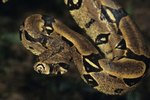
Red tegus (Tupinambis rufescens), also called Argentine tegus, are the largest members of the lizard genus Tupinambis, which contains six other tegu species. Tegus are agile, powerful lizards with a reputation for aggressiveness. Red tegus are highly prized and continue to gain popularity as pets. Although regarded as the most docile of the tegus, red tegus can never be completely domesticated and are not recommended for beginners.
Tupinambis Rufescens 101
Red tegus have solid, stocky bodies with large heads, tapered snouts and forked tongues. Their rounded tails are longer than their bodies. They grow up to 4 1/2 feet long and weigh up to 20 pounds. Young tegus are reddish-brown in color. As they mature, the males' coloring intensifies while females remain the same shade but develop white spots. Diurnal in nature, they emerge from their burrows only in daylight to bask in the sun, chomp on fresh fruit or hunt for insects and mice. They prefer to remain earthbound, but will climb trees to raid birds' nests and are competent swimmers, enjoying an occasional soak or bath.
Wild Behavior
Red tegus display little fear of humans, often living in close proximity to villages and suburbs. They've been observed begging for food from fisherman or park visitors. However, if cornered or threatened, the red tegu will launch an unyielding, volatile attack. Like a tiny ninja, the tegu uses his entire body to defend himself, clamping down hard with powerful jaws lined with conical teeth, scratching with razor-sharp claws, and whipping his tail with enough force to inflict painful lacerations.
Captive Behavior
Red tegus make fascinating pets, but they're not suitable for beginners. Although some tolerate handling well, they'll never be domesticated like a dog or cat, even when raised in captivity. They'll always be wild animals at heart and capable of unpredictable behavior. Captive tegus may bite for what seems to you unprovoked reasons, but the tegu knows. Merely cleaning out his enclosure can, at times, be enough to annoy your tegu. Young tegus should be handled at least 15 to 20 minutes per day to acclimate them to the process. Some professionals recommend wearing heavy gloves when handling adults, even for experienced handlers.
Food Fight
Red tegus are aggressive feeders, so you must avoid allowing your tegu to associate you with food. Never feed your tegu by hand. You may opt to feed your tegu in a different enclosure than his primary living area. Put the food in the feeding enclosure before you place your tegu inside. Or, you can place food in the primary living area at night while your tegu is in his hide, then he will not see you with the food. Just be careful to place the food in a spot that does not allow your tegu to ingest substrate, as this can lead to intestinal blockages.
Mother's Instincts
Aggression in female tegus is heightened during nesting periods, which take place from May through August. Even the tamest tegu will become aggressive, attacking other tegus as well as her keeper. This typically continues after the eggs are collected and the nest is gone. Females remain in aggressive guard mode until they go into hibernation in September, and do not cease until they emerge from hibernation the following spring.
The Threat Display
If your tegu is growing weary of handling or feeling provoked for any reason, he will typically enact a threat display. He tenses his body and inflates his throat, emitting a series of short huffs. He repeatedly flicks his tongue. This is the time to back off and let your tegu calm down. If you don't take the hint, you may bear witness as your tegu raises up on his legs, puffs out his chest and opens his jaws wide to display rows of razor-sharp teeth. That will most likely be your final warning before a bite.
References
Resources
Photo Credits
-
Jupiterimages/liquidlibrary/Getty Images
Writer Bio
Yvette Sajem has been a professional writer since 1995. Her work includes greeting cards and two children's books. A lifelong animal advocate, she is active in animal rescue and transport, and is particularly partial to senior and special needs animals.




